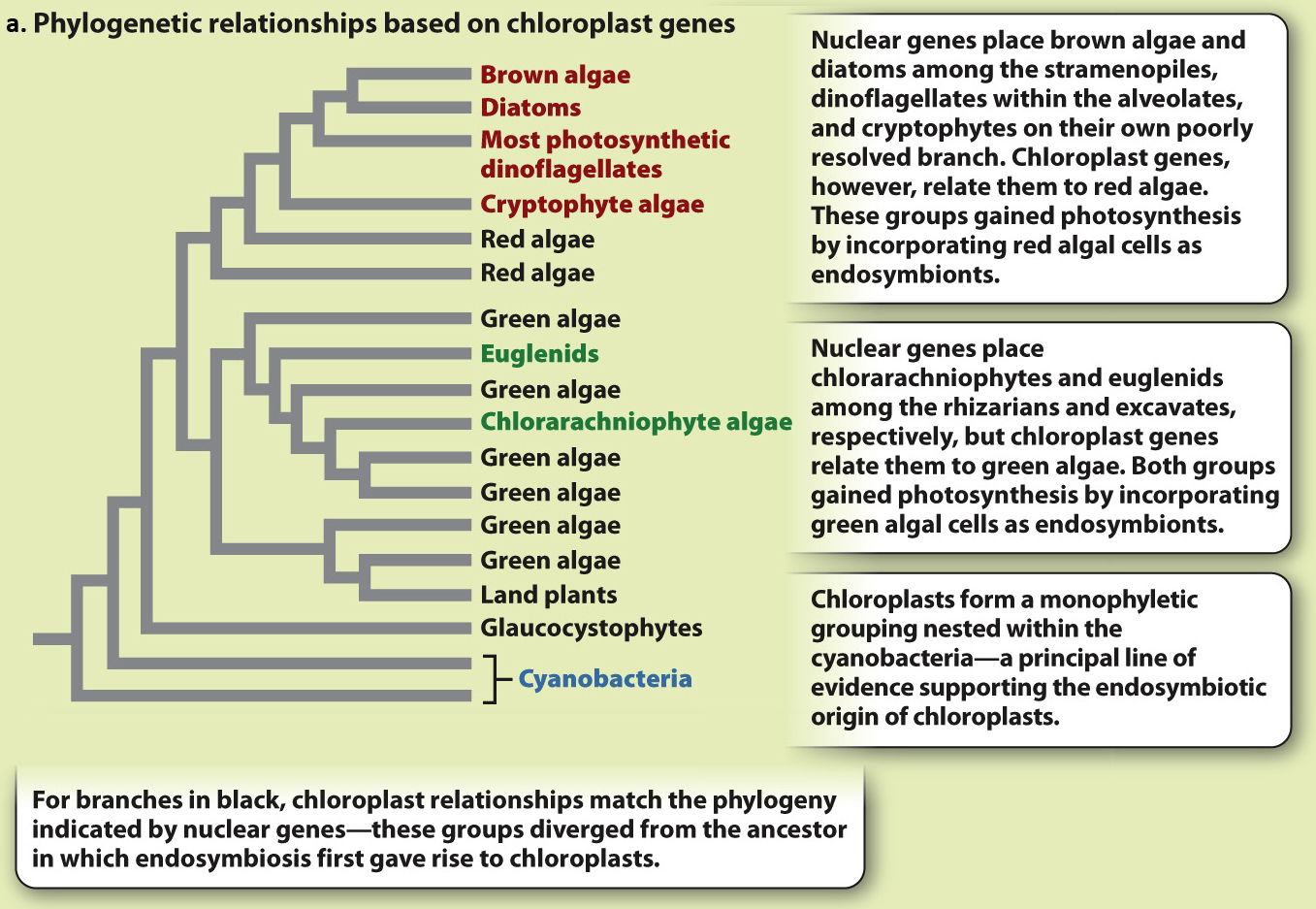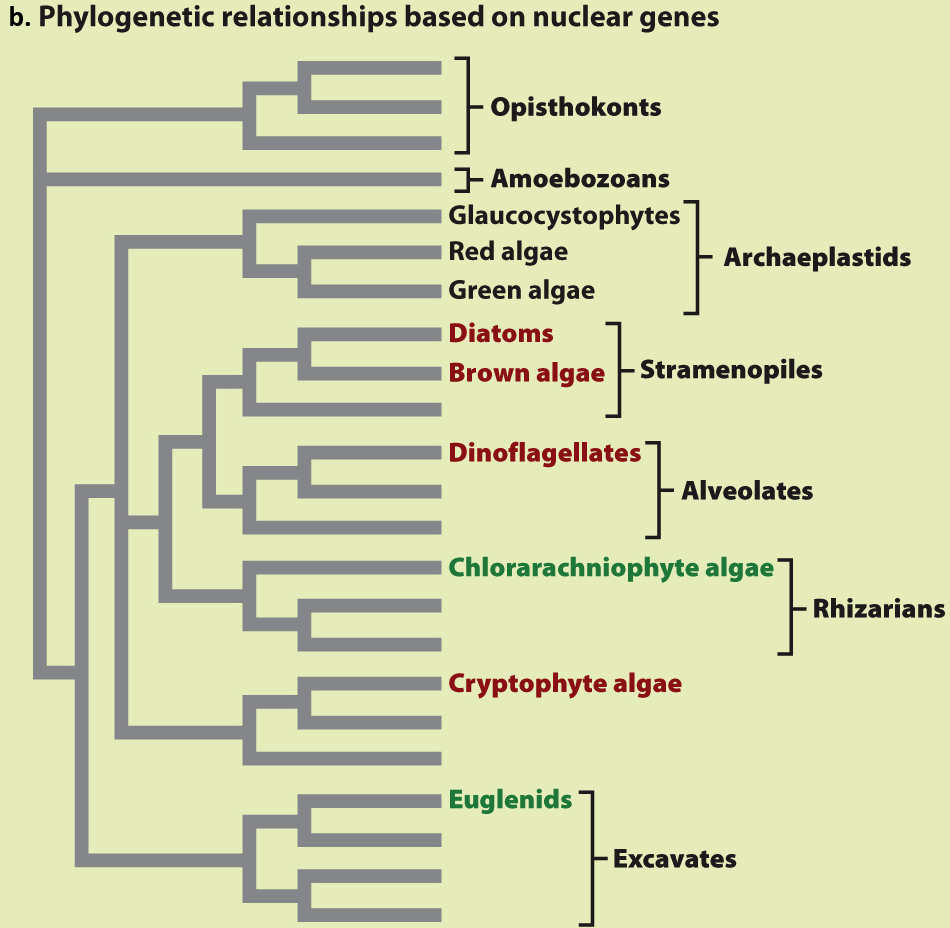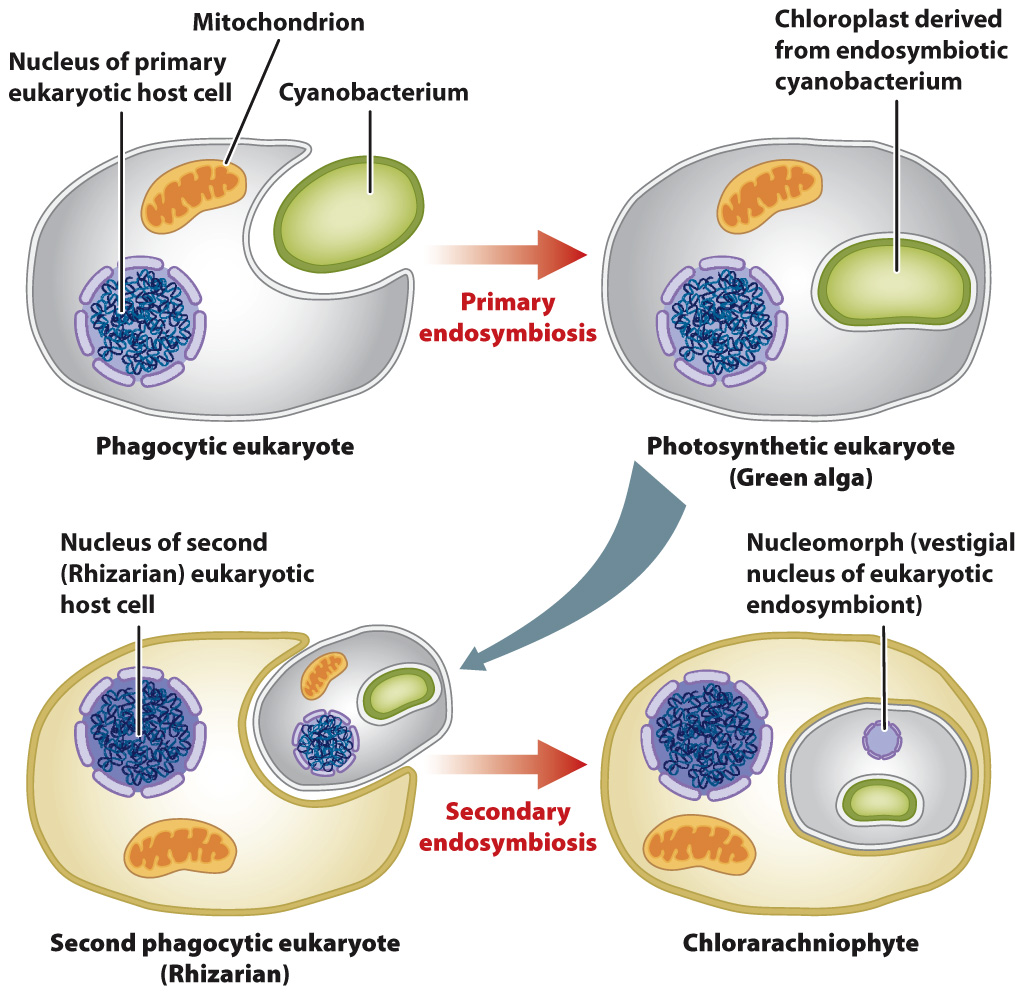Photosynthesis spread through eukaryotes by repeated endosymbioses involving eukaryotic algae.
A curious feature of the eukaryotic tree is that photosynthetic eukaryotes are distributed widely but discontinuously among its branches (see Fig. 27.9). How can we explain this pattern?
As explored in Fig. 27.20, two hypotheses have been suggested: Either photosynthesis was established early in eukaryotic evolution and then subsequently lost in some lineages, or eukaryotes acquired photosynthesis multiple times by repeated episodes of endosymbiosis. The second hypothesis, it turns out, is correct. The twist is that most of the symbionts involved in the spread of photosynthesis across eukaryotic phylogeny were photosynthetic eukaryotes, not cyanobacteria.
571
HOW DO WE KNOW?
FIG. 27.20
How did photosynthesis spread through the Eukarya?
BACKGROUND Many different branches on the eukaryotic tree include photosynthetic species, commonly interspersed with non-
HYPOTHESIS 1 Photosynthesis was established early in eukaryotic evolution and was subsequently lost in some lineages.
HYPOTHESIS 2 Eukaryotes acquired photosynthesis multiple times by repeated episodes of endosymbiosis.
PREDICTIONS The two hypotheses make different predictions. If photosynthesis were acquired in a single common ancestor of all living eukaryotes and then lost in some lineages, we would expect chloroplast and nuclear gene phylogenies to show the same pattern of branching. If photosynthesis were acquired multiple independent times, we would expect chloroplast and nuclear phylogenies to show different patterns.
EXPERIMENT Chloroplasts have DNA, so scientists developed a phylogenetic tree based on molecular sequence comparison of chloroplast genes (Fig. 27.20a). This phylogeny was then compared with a second phylogeny, for all eukaryotes, based on molecular sequence comparison of nuclear genes (Fig. 27.20b).


RESULTS Molecular sequence comparisons show that evolutionary relationships among chloroplasts do not mirror those based on nuclear genes. The chlorarachniophyte algae and photosynthetic euglenids (shown in green) fall in a monophyletic group with the green algae when chloroplast DNA is analyzed (Fig. 27.20a). However, these groups lie far from green algae in the phylogeny based on nuclear genes (Fig. 27.20b). Similarly, brown algae, diatoms, most photosynthetic dinoflagellates, and cryptophyte algae (shown in red) form a monophyletic group with the red algae in the phylogeny based on chloroplast DNA (Fig. 27.20a), but analysis of nuclear genes places them in different groups (Fig. 27.20b).
CONCLUSION The chloroplast and nuclear phylogenies show different patterns of branching, supporting the hypothesis that photosynthesis spread through the Eukarya by means of multiple eukaryotic endosymbionts.
SOURCE Hackett, J. D., et al. 2007. “Plastid Endosymbiosis: Sources and Timing of the Major Events.” In Evolution of Primary Producers in the Sea, edited by P. G. Falkowski and A. H. Knoll, 109–
Once more, DNA sequence comparisons provide the decisive data. We can construct phylogenetic trees for photosynthetic eukaryotes using chloroplast genes and then repeat the exercise using nuclear genes. Comparing the two trees, as shown in Fig. 27.20, reveals that two groups, chlorarachniophytes and euglenids, gained photosynthesis by establishing green algal cells as endosymbionts. (The algal cells contained chloroplasts derived from an earlier symbiotic assimilation of cyanobacteria.) Other groups (including brown algae, diatoms, most photosynthetic dinoflagellates, and cryptophyte algae) gained photosynthesis as well, but most likely by ingesting a photosynthetic endosymbiont that was a red algal cell.
572
Several features of cell biology support the view that eukaryotes acquired photosynthesis multiple times by repeated episodes of endosymbiosis. The chloroplasts of euglenids and chloarachniophyte algae contain chlorophyll a and b, like green algae, whereas cryptophytes contain chlorophyll c, a form of chlorophyll not known from either red or green algae, along with chlorophyll a and biliproteins, both found in red algae. (Diatoms, brown algae and their relatives contain chlorophyll a and c, but not biliproteins.)
We noted earlier that chloroplasts in green and red algae are bounded by two membranes, but most of the algae shown in red and green in Fig. 27.20 have chloroplasts bounded by four membranes. The presence of four membranes is expected under the hypothesis of eukaryotic endosymbionts: The inner two membranes are those that bounded the chloroplast in the green or red algal endosymbiont, the third membrane is derived from the outer cell membrane of the symbiont, and the fourth, outer membrane is part of the cell membrane of the host (Fig. 27.21).

Chlorarachniophyte algae also retain another feature that supports the eukaryotic origin of their chloroplasts: a small organelle called a nucleomorph (Fig. 27.21). The nucleomorph in chlorarachniophyte algae is, in fact, the remnant nucleus of a green algal symbiont. It retains only a few genes, but those show close phylogenetic affinity with green algae. Nucleomorph genes in cryptophyte algae similarly provide evidence for a red algal symbiont.
How many endosymbiotic events are required to account for the diversity of photosynthetic eukaryotes? There was the primary endosymbiosis that gave rise to green and red algae, two further events that established chloroplasts derived from green algae in euglenids and chlorarachniophytes, and at least one to three events that established chloroplasts derived from red algae in cryptophytes, haptophytes, and stramenopiles.
The dinoflagellates add a remarkable coda to this accounting. Like stramenopiles, most dinoflagellates have chloroplasts derived from red algae. Three dinoflagellate groups, however, have chloroplasts that are clearly derived from green, cryptophyte, and haptophyte algae. Include Paulinella and at least 8 to 10 endosymbiotic events are required to explain eukaryotic photosynthesis. Eukaryotes never evolved oxygenic photosynthesis—
Quick Check 3 How do the molecular sequences of genes in chloroplasts show how photosynthesis spread throughout the eukaryotic domain?
Quick Check 3 Answer
Molecular sequences for genes in red and green algae show the close evolutionary relationship of these organelles to free-